How can I ensure consistent thickness and metallization uniformity in high barrier metallized cpp film?
High barrier metallized cpp film has become an essential material in modern packaging, particularly in food, pharmaceuticals, and sensitive product applications. Its popularity stems from its excellent barrier properties, light weight, and flexibility. However, achieving consistent thickness and uniform metallization is a critical concern for both manufacturers and buyers. Variations in film thickness or metallization can compromise barrier performance, appearance, and mechanical properties.
Understanding high barrier metallized cpp film
High barrier metallized cpp film is a type of biaxially oriented polypropylene (CPP) film coated with a thin metallic layer, usually aluminum, to improve barrier properties against oxygen, moisture, and light. The metallization process enhances the film’s protective function while retaining the flexibility and heat-sealability of CPP. This combination makes it suitable for packaging sensitive products that require extended shelf life, such as snacks, coffee, pharmaceuticals, and other high-value goods.
From a production standpoint, high barrier metallized cpp film involves multiple steps: extrusion of CPP, biaxial orientation, surface treatment, metallization, and sometimes lamination or coating. Any inconsistency during these steps can lead to uneven thickness, poor metallization, or compromised barrier performance.
Key factors affecting thickness and metallization uniformity
Several factors play a role in achieving consistent thickness and metallization uniformity in high barrier metallized cpp film:
1. Film extrusion and orientation
The foundation of consistent metallization starts with the CPP base film. Uniformity in thickness during extrusion is essential. Variations in film thickness can result in uneven metallization coverage, creating weak points in barrier performance.
Biaxial orientation aligns polymer chains in both machine and transverse directions, enhancing strength and optical clarity. However, inconsistent stretching or uneven cooling during orientation can introduce thickness variations.
2. Surface treatment
Before metallization, surface treatment like corona or plasma treatment improves adhesion between the CPP film and the metal layer. Insufficient or uneven treatment can lead to poor metallization coverage, peeling, or inconsistent appearance. High uniformity in surface energy across the film is crucial for maintaining consistent metallization.
3. Metallization process control
The metallization step itself is sensitive to multiple parameters. Factors such as deposition rate, vacuum level, and the uniformity of metal vapor distribution directly impact the final product.
- Deposition rate: Too fast or too slow a rate can create uneven layers or cause defects.
- Vacuum environment: Fluctuations in vacuum pressure can affect the density and adhesion of the metallic layer.
- Roller speed and tension: Proper tension ensures even exposure of the film to metal vapor, reducing streaks or thin spots.
Methods to ensure consistent thickness
1. In-line thickness monitoring
Advanced production lines for high barrier metallized cpp film employ in-line thickness measurement systems, such as beta gauges or optical sensors. These tools monitor the film thickness in real time and can trigger adjustments automatically to correct deviations.
2. Quality control at multiple stages
Measuring thickness only at the end of production is insufficient. Continuous monitoring during extrusion, orientation, and metallization stages is recommended. Regular calibration of measurement instruments ensures reliable readings.
3. Process optimization
Optimizing extrusion parameters, cooling rate, and stretching conditions minimizes variation in film thickness. Consistency in raw material quality and temperature control is also crucial.
Ensuring metallization uniformity
1. Maintaining vacuum and deposition parameters
A stable vacuum environment and controlled metal evaporation rate are essential. Modern metallizers are equipped with precise control systems to maintain these conditions. Even minor fluctuations can create streaks or variations in reflectivity.
2. Uniform film handling
The way the film is unwound, guided, and wound during metallization can influence uniformity. Misalignment, inconsistent tension, or contact with contaminated rollers can compromise metallization quality.
3. Surface cleanliness and treatment
As previously mentioned, uniform surface energy across the film ensures the metal adheres evenly. Dust, oils, or other contaminants can lead to patchy metallization, reducing barrier performance.
4. Post-metallization inspection
Visual and instrumental inspection of the metallized film is necessary to detect defects such as pinholes, streaks, or uneven gloss. These inspections can involve optical sensors, thickness mapping, or barrier testing to verify uniformity.
Impact of inconsistent thickness and metallization
Variations in thickness or metallization can significantly affect performance and usability:
- Barrier performance: Thin spots or poorly metallized areas allow moisture or oxygen ingress, shortening product shelf life.
- Mechanical strength: Uneven thickness may create weak areas prone to tearing or puncturing.
- Appearance: Inconsistent metallization can result in visual defects like streaks or cloudiness, affecting consumer perception.
- Heat-sealing behavior: Variations in film thickness can lead to inconsistent sealing strength, impacting package integrity.
Industry practices and standards
To meet buyer expectations, manufacturers of high barrier metallized cpp film often follow strict quality management practices:
- ISO and ASTM testing standards: Regular testing of barrier properties, tensile strength, and metallization adhesion ensures product consistency.
- Batch traceability: Maintaining records of production parameters allows for rapid troubleshooting and quality verification.
- Supplier audits: Buyers often require detailed specifications and certifications to ensure that the film meets their standards.
Common challenges and solutions
| Challenge | Solution |
|---|---|
| Uneven film thickness | Implement in-line thickness sensors, adjust extrusion and orientation parameters |
| Poor metal adhesion | Ensure consistent corona treatment, clean film surfaces, control vacuum and deposition parameters |
| Streaks or patchy metallization | Maintain roller alignment and tension, optimize deposition rate and vacuum conditions |
| Barrier failure in end-use | Conduct routine barrier testing and post-metallization inspections |
Practical tips for buyers and manufacturers
- Specify tolerance ranges: Buyers should communicate acceptable limits for film thickness and metallization uniformity.
- Request test reports: Regular test reports on OTR, WVTR, and metallization coverage can verify quality.
- Evaluate sample rolls: Conduct trial runs to assess sealing behavior, barrier performance, and appearance.
- Collaborate on process improvements: Close cooperation between supplier and buyer can optimize metallization techniques for specific applications.
Conclusion
Ensuring consistent thickness and metallization uniformity in high barrier metallized cpp film is a multifaceted challenge requiring careful attention to raw materials, production parameters, and quality control measures. By focusing on film extrusion, surface treatment, metallization processes, and rigorous inspection protocols, manufacturers can produce high-quality films that meet demanding buyer requirements. Buyers, in turn, can safeguard product shelf life, appearance, and mechanical performance by specifying standards, evaluating test data, and maintaining communication with suppliers.
With the increasing demand for flexible, high-performance packaging, understanding and controlling these critical factors is essential for success in both manufacturing and end-use applications of high barrier metallized cpp film.


 English
English  中文简体
中文简体 





